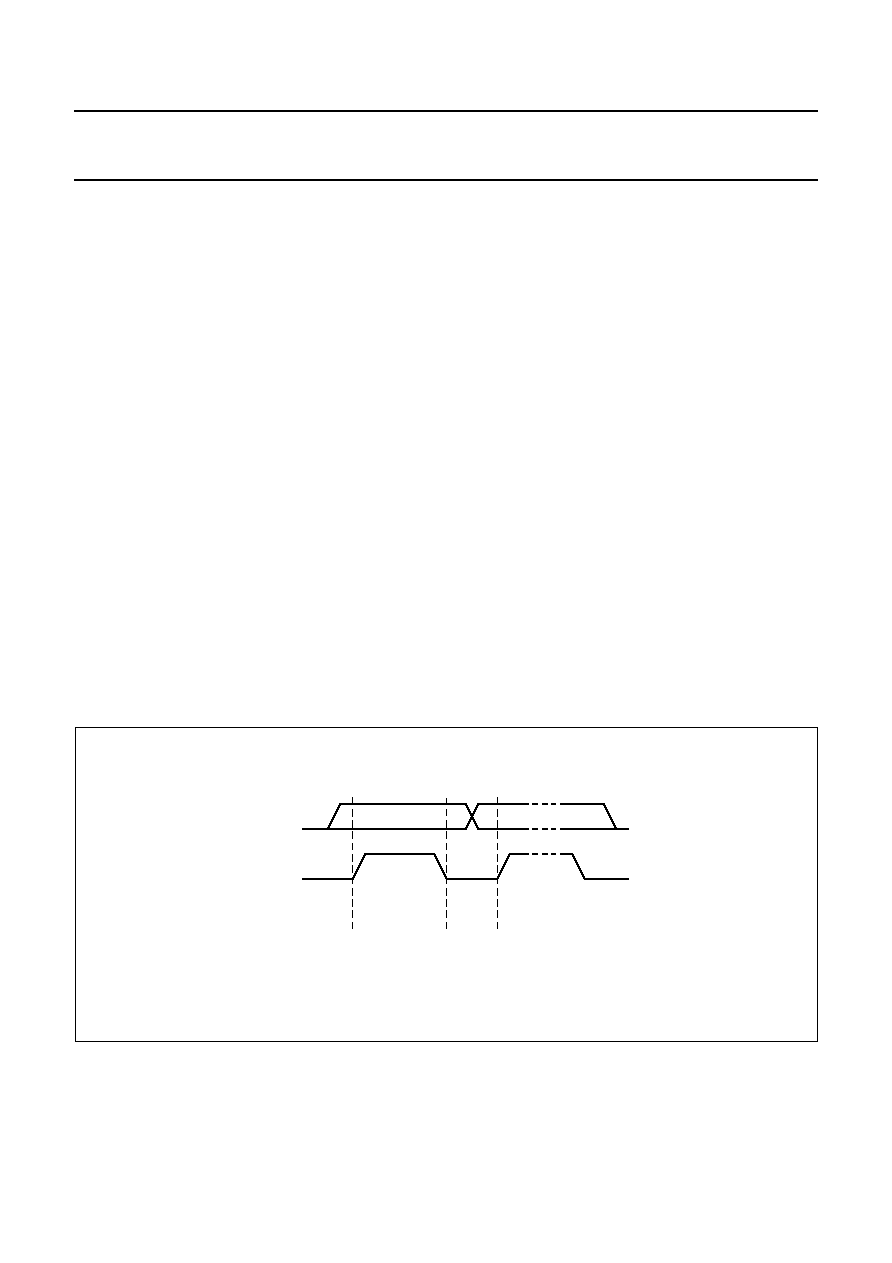- 您現(xiàn)在的位置:買賣IC網(wǎng) > PDF目錄24670 > 933865300112 (NXP SEMICONDUCTORS) LIQUID CRYSTAL DISPLAY DRIVER, PDSO40 PDF資料下載
參數(shù)資料
| 型號(hào): | 933865300112 |
| 廠商: | NXP SEMICONDUCTORS |
| 元件分類: | 顯示驅(qū)動(dòng)器 |
| 英文描述: | LIQUID CRYSTAL DISPLAY DRIVER, PDSO40 |
| 封裝: | PLASTIC, SOT-158-1, VSOP-40 |
| 文件頁數(shù): | 9/40頁 |
| 文件大?。?/td> | 243K |
| 代理商: | 933865300112 |
第1頁第2頁第3頁第4頁第5頁第6頁第7頁第8頁當(dāng)前第9頁第10頁第11頁第12頁第13頁第14頁第15頁第16頁第17頁第18頁第19頁第20頁第21頁第22頁第23頁第24頁第25頁第26頁第27頁第28頁第29頁第30頁第31頁第32頁第33頁第34頁第35頁第36頁第37頁第38頁第39頁第40頁

1998 May 04
17
Philips Semiconductors
Product specication
Universal LCD driver for low multiplex
rates
PCF8566
7I2C-BUS DESCRIPTION
The I2C-bus is for 2-way, 2-line communication between
different ICs or modules. The two lines are a serial data
line (SDA) and a serial clock line (SCL). Both lines must be
connected to a positive supply via a pull-up resistor when
connected to the output stages of a device. Data transfer
may be initiated only when the bus is not busy.
7.1
Bit transfer
One data bit is transferred during each clock pulse.
The data on the SDA line must remain stable during the
HIGH period of the clock pulse as changes in the data line
at this time will be interpreted as control signals.
7.2
Start and stop conditions
Both data and clock lines remain HIGH when the bus is not
busy. A HIGH-to-LOW transition of the data line while the
clock is HIGH is defined as the START condition (S).
A LOW-to-HIGH transition of the data line while the clock
is HIGH is defined as the STOP condition (P).
7.3
System conguration
A device generating a message is a ‘transmitter’, a device
receiving a message is a ‘receiver’. The device that
controls the message is the ‘master’ and the devices which
are controlled by the master are the ‘slaves’.
7.4
Acknowledge
The number of data bytes transferred between the START
and STOP conditions from transmitter to receiver is not
limited. Each byte is followed by one acknowledge bit.
The acknowledge bit is a HIGH level put on the bus by the
transmitter whereas the master generates an extra
acknowledge related clock pulse. A slave receiver which is
addressed must generate an acknowledge after the
reception of each byte. Also a master must generate an
acknowledge after the reception of each byte that has
been clocked out of the slave transmitter. The device that
acknowledges has to pull down the SDA line during the
acknowledge clock pulse, so that the SDA line is stable
LOW during the HIGH period of the acknowledge related
clock pulse, set up and hold times must be taken into
account. A master receiver must signal an end of data to
the transmitter by not generating an acknowledge on the
last byte that has been clocked out of the slave. In this
event the transmitter must leave the data line HIGH to
enable the master to generate a STOP condition.
Fig.11 Bit transfer.
MBA607
data line
stable;
data valid
change
of data
allowed
SDA
SCL
相關(guān)PDF資料 |
PDF描述 |
|---|---|
| 933865300118 | LIQUID CRYSTAL DISPLAY DRIVER, PDSO40 |
| 933865310112 | LIQUID CRYSTAL DISPLAY DRIVER, PDIP40 |
| 935263625026 | LIQUID CRYSTAL DISPLAY DRIVER, U |
| 0561168228 | PHOSPHOR BRONZE, TIN (40) FINISH, WIRE TERMINAL |
| 933876860602 | F/FAST SERIES, POSITIVE EDGE TRIGGERED D FLIP-FLOP, TRUE OUTPUT, PDIP16 |
相關(guān)代理商/技術(shù)參數(shù) |
參數(shù)描述 |
|---|---|
| 933871-1 | 制造商:TE Connectivity 功能描述:GUIDE, MODIFIED - Bulk |
| 9-338728-0 | 功能描述:集管和線殼 MICROM. MOB SMD CON RoHS:否 產(chǎn)品種類:1.0MM Rectangular Connectors 產(chǎn)品類型:Headers - Pin Strip 系列:DF50 觸點(diǎn)類型:Pin (Male) 節(jié)距:1 mm 位置/觸點(diǎn)數(shù)量:16 排數(shù):1 安裝風(fēng)格:SMD/SMT 安裝角:Right 端接類型:Solder 外殼材料:Liquid Crystal Polymer (LCP) 觸點(diǎn)材料:Brass 觸點(diǎn)電鍍:Gold 制造商:Hirose Connector |
| 933873-1 | 制造商:TE Connectivity 功能描述:PLATE, CYL MTG. - Bulk |
| 933879-8 | 制造商:TE Connectivity 功能描述:WHEEL, WIRE SELECTOR - Bulk |
| 933879-9 | 制造商:TE Connectivity 功能描述:WHEEL, WIRE SELECTOR - Bulk |
發(fā)布緊急采購,3分鐘左右您將得到回復(fù)。